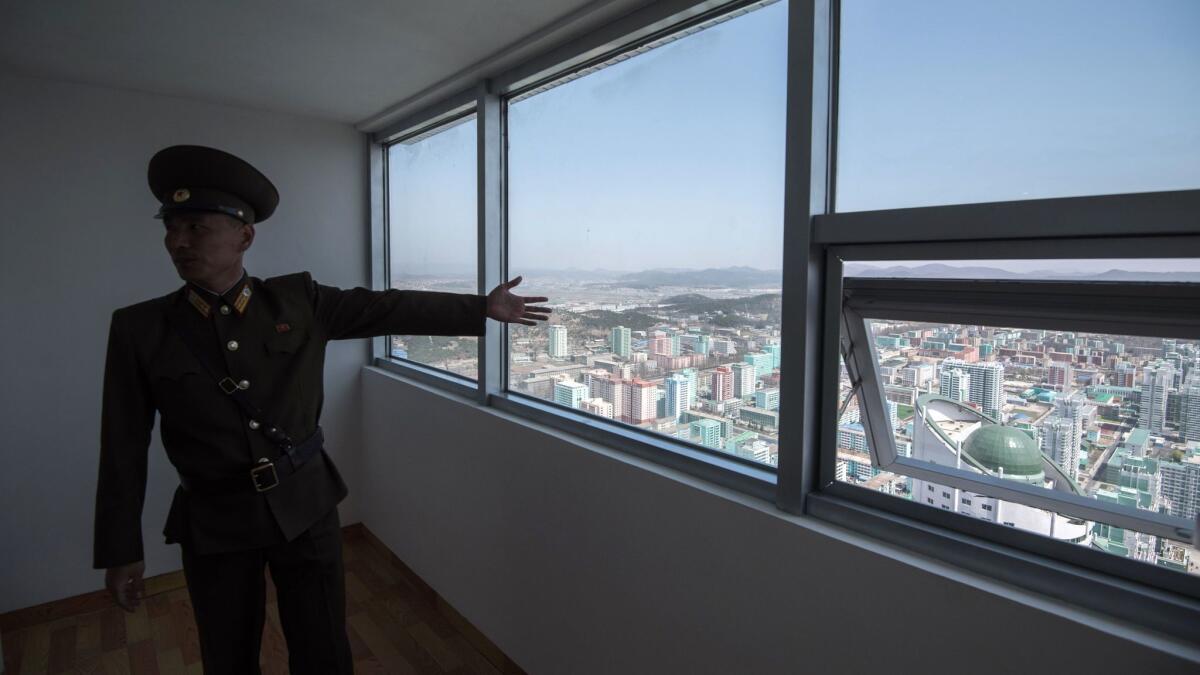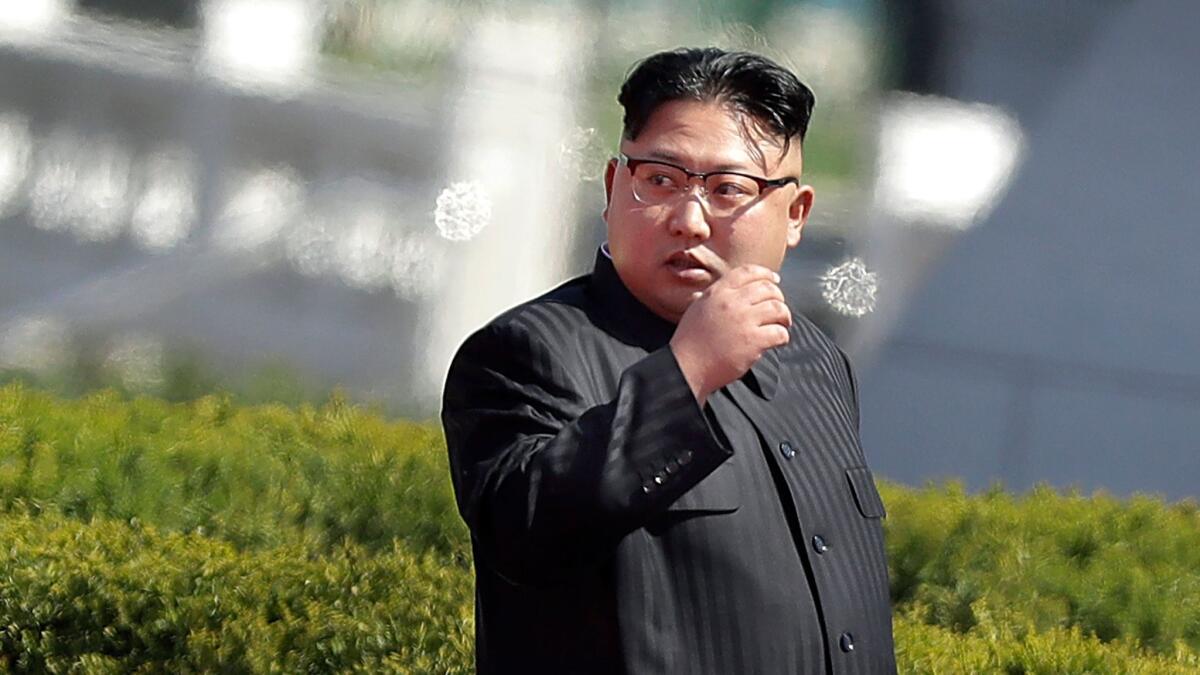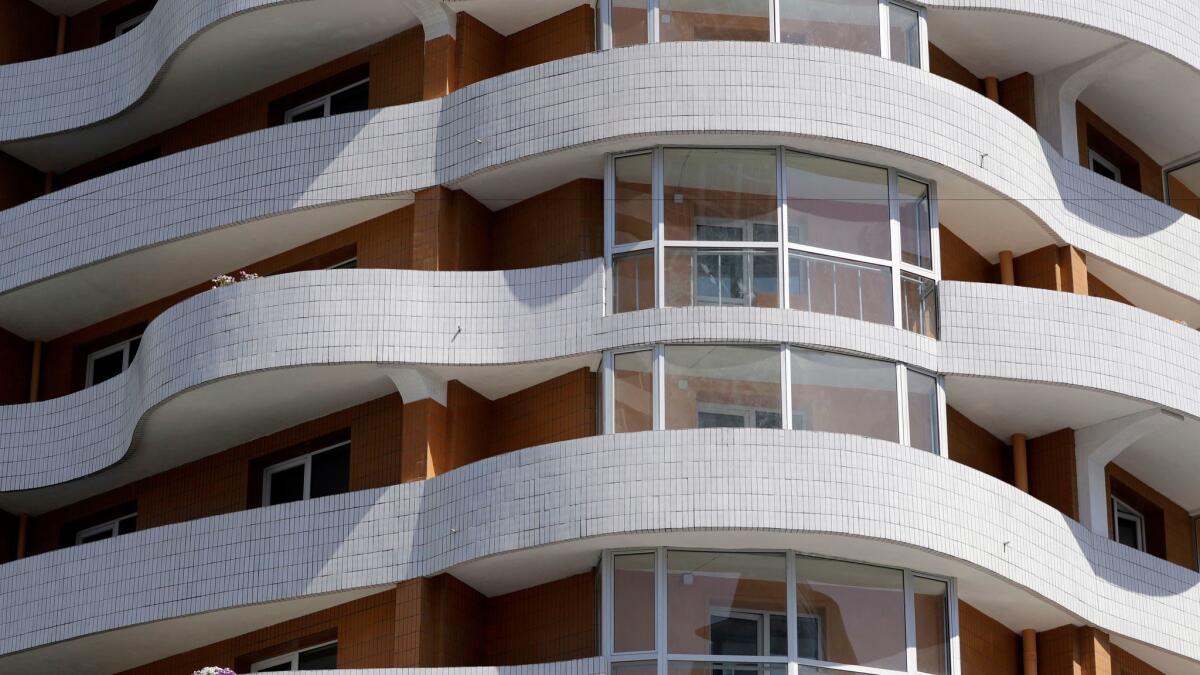Why a North Korean leader called a gleaming new neighborhood ‘more powerful than 100 nuclear warheads’
- Share via
Reporting from Pyongyang, North Korea — The North Koreans streamed in for hours — black-suited officials, women in colorful dresses, grim-faced military men — until they were a heaving mass in central Pyongyang, packed so tightly that the air above them shimmered from rising heat.
The occasion was a ribbon cutting ceremony for Ryomyong Street, a residential high-rise project which, according to North Korean state media, was personally overseen by the country’s Supreme Leader Kim Jong Un. The crowd, tens of thousands strong, waited for hours — and when Kim arrived, it roared. He stood on a red-carpeted stage, framed by the street’s pastel-colored edifices of tile and glass.
“The completion of this street is more powerful than 100 nuclear warheads,” Prime Minister Pak Pong-ju said in a speech.
Kim himself said nothing. But his intended message was clear: that North Korea still possesses economic power, despite international sanctions over its nuclear program and the rising threat of military conflict with the U.S.
Several dozen foreign journalists have arrived in North Korea — perhaps the world’s most isolated and restrictive country — as part of a government-sponsored tour to mark the 105th birthday of Kim Il Sung, North Korea’s founder and Kim Jong Un’s grandfather, who died in 1994.
The trip is tightly controlled: Every journalist is assigned a North Korean government minder, and is not permitted to conduct independent interviews or leave the hotel alone. So it is virtually impossible to corroborate the portrait being painted by North Korean officials.
Yet experts say that the government’s boasts of economic growth check out. Kim, they say, tacitly approves of simple commerce — and this alone is beginning to transform the staunch Communist state.

In Pyongyang’s city center, signs of new wealth are everywhere. Gleaming new buildings flank freshly paved thoroughfares, some teeming with traffic. Men wear suits and ties; women carry designer handbags. Streetside shops sell bananas, apples and peaches, likely imported from China.
“It’s very simple — you know, capitalism works,” said Andrei Lankov, a North Korea expert at Kookmin University in Seoul. “What [Kim] did is, essentially, he began to implement something very similar to what China did in the early 1980s. He’s doing it much more carefully than the Chinese did it — much more carefully. But he is doing it. And it works.”
Yet Kim is as repressive as his forebears, Lankov added, and has taken an even harder line on foreign influence. He has fortified the Chinese border — once a major crossing point for foreign goods — and cracked down on private entrepreneurs distributing South Korean entertainment.
“I’d call his policy ‘reform without openness,’” Lankov said. “It takes from China the economic component. But when it comes to policies, he does what he can to maintain his father and grandfather’s system of maintaining absolute control. Is it possible to have economic growth under such a system? I’m inclined to say yes. Is it possible to have really fast growth? I’d say no, but only time will tell.”
His own nuclear ambitions have raised the specter of military conflict with the U.S. Analysts expect Kim to conduct a nuclear or missile test to mark his grandfather’s birthday on Saturday, the country’s most important holiday. President Trump has suggested that the U.S. could attack North Korea in retaliation; and North Korea, in turn, has said that it could respond with a nuclear strike on the U.S.
Yet Kim appeared calm at the event on Thursday, his posture straight, his hands clasped behind his back. The ceremony lasted about 20 minutes. After Pak concluded his speech, a military band began playing a Communist anthem; Kim stepped into his black Mercedes limousine; and the applause abruptly stopped, plunging the square into a minute-long silence. Then the crowd dispersed.

Preparations for the event were shrouded in secrecy, underscoring the importance of the project to North Korea’s government. Minders roused the foreign journalists at 4:30 a.m. for an unspecified “major event,” and instructed them to leave phones, computers, and water at the hotel; they claimed to have no further information. Kim’s appearance was a surprise.
After the ceremony, participants — none of whom would give their names to a foreign reporter — said that they were impressed by the speed of Ryomyong Street’s construction. The street contains about two dozen buildings, all built in less than a year, North Korean officials said.
“The reason was that Supreme Leader Kim Jong Un is very kind to our people, and loves the people very much,” said one, a woman wearing a pin bearing Kim Il Sung’s portrait.
“It means other countries can’t copy our construction methods,” said another, a man in a black suit.

North Korea is still far from achieving economic self-sufficiency. Satellite images on Google Maps show that behind the prim residential buildings lining Pyongyang’s main streets lie huge warrens of traditional homes, invisible to foreign guests. And outside the city — a metropolis of about 3 million people in the largely agrarian country of about 25 million — development has come slowly, if at all.
“Once you leave Pyongyang, you see more,” said Robert Kelly, a professor of political science at Pusan National University in Seoul. “You see that the rest of the country looks like Mozambique. The roads fall apart. You go to places without toilets. It’s really bad — Pyongyang is like an isolated little city-state surrounded by a rural piedmont.”
One day before a Times reporter flew to Pyongyang, a North Korean official who helped arrange the trip sent an email.
“I am writing to kindly request you to bring in a few pieces of printer cartridges to be donated to the Institute of American Study who will assist and take care of your trip,” it said, then listed two specific types of cartridges. The Institute of American Study is run by North Korea’s Ministry of Foreign Affairs.
One newspaper reporter who was invited on a similar trip in 2016 said a North Korean official asked him to donate several specific pieces of hockey gear. (Sanctions block the sale of some sporting goods to North Korea.)
The minder assigned to The Times accepted a Chinese knockoff of an HP cartridge, but looked confused. He appeared to know nothing about the foreign ministry’s printers.
Nevertheless, he carried the cartridge throughout the evening, and eventually appeared to hand it off, presumably to its intended recipient.
For more news from Asia, follow @JRKaiman on Twitter
ALSO
Trump to China: Help us rein in North Korea and we’ll back off on trade issues
In China, the United Airlines incident unleashes frustration about treatment of Asians in America
Why Russia might be working with its Cold War enemy, the Taliban
More to Read
Sign up for Essential California
The most important California stories and recommendations in your inbox every morning.
You may occasionally receive promotional content from the Los Angeles Times.










